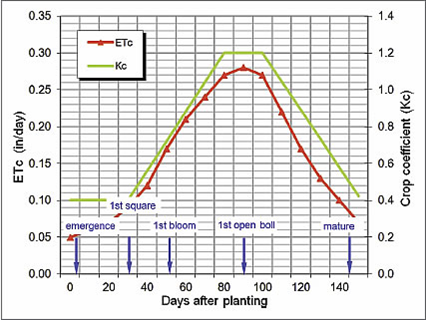Right now, the maturity of the cotton crop across the panhandle is highly variable, with some fields just cracking, and others approaching layby in a couple of weeks. That being said, this is the time of year for growers to implement strategic irrigation plans that will, regardless of maturity, carry their crops to harvest without wasting money from over or under application.
On average, cotton uses about 22 inches of well-timed water per season to achieve maximum yields. Water-use is very low as the crop emerges on through the development of the first squares. From the first square, water-use steadily increases until it reaches its peak daily demand around the time when the first bolls start to open. During this period, a cotton crop can use over an inch of water per day from evapotranspiration (plant transpiration plus soil evaporation).

Water use curve for a cotton crop where the red line shows actual cotton water use through the season. Published by Cotton Inc.
How often and how much should I irrigate?
This is a hard question to answer, as there are many variables that affect crop water use including crop stage, soil type, rainfall, humidity, and temperature. However, there are tools that can help the grower manage irrigation more efficiently. These tools include, soil moisture sensors, growing degree day (GDD) calculators, checkbook irrigation schedulers, and others.
Checkbook Irrigation Scheduling
A checkbook irrigation scheduling method works very similar to balancing a check book for a bank account. All that is required is that you keep track of deposits (rainfall and irrigation amounts) and withdrawals (the amount of water used by the crop each day). When the balance gets close to zero you would irrigate (deposit) to bring the balance back up.
If you are interested in using a paper-based or Microsoft Excel version of an irrigation scheduler checkbook for cotton, peanut, or soybean, contact Josh Thompson at the UF/IFAS Jackson County Extension Service. For more information on cotton water use, see Water Use and Irrigation Management of Agronomic Crops.
- Carinata Starting to Come Up in Jackson County - December 12, 2014
- Wheat Production Considerations for 2014-2015 - November 10, 2014
- Peanut and Cotton Harvest Video 2014 - November 10, 2014

